 The Still House at John's Lane Distillery, as it looked when Alfred Barnard visited in the 1800s.
The Still House at John's Lane Distillery, as it looked when Alfred Barnard visited in the 1800s.
-
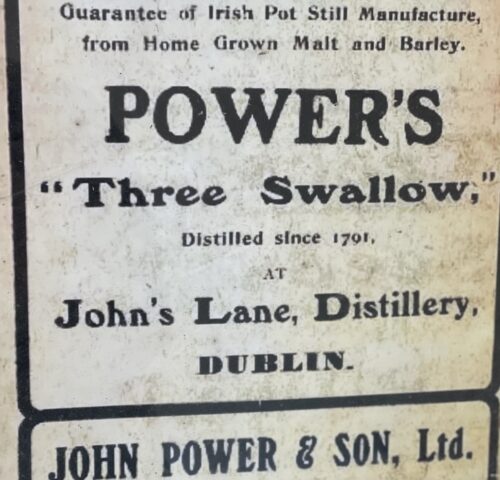
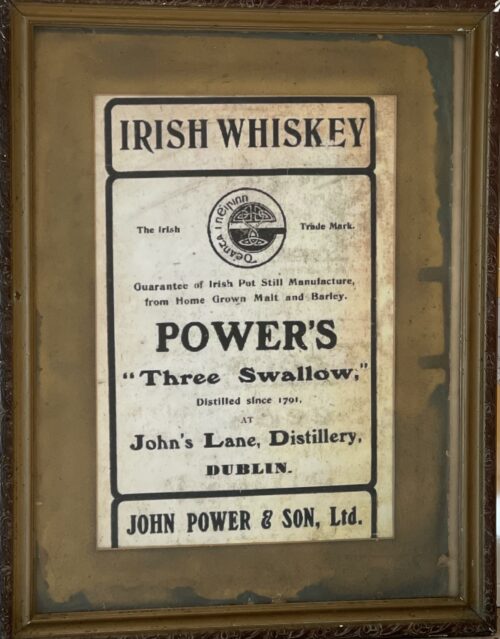 48cm x 38cm Limerick In 1791 James Power, an innkeeper from Dublin, established a small distillery at his public house at 109 Thomas St., Dublin. The distillery, which had an output of about 6,000 gallons in its first year of operation, initially traded as James Power and Son, but by 1822 had become John Power & Son, and had moved to a new premises at John's Lane, a side street off Thomas Street. At the time the distillery had three pot stills, though only one, a 500-gallon still is thought to have been in use. Following reform of the distilling laws in 1823, the distillery expanded rapidly. In 1827, production was reported at 160,270 gallons,and by 1833 had grown to 300,000 gallons per annum. As the distillery grew, so too did the stature of the family. In 1841, John Power, grandson of the founder was awarded a baronet, a hereditary title. In 1855, his son Sir James Power, laid the foundation stone for the O'Connell Monument, and in 1859 became High Sheriff of Dublin. In 1871, the distillery was expanded and rebuilt in the Victorian style, becoming one of the most impressive sights in Dublin.After expansion, output at the distillery rose to 700,000 gallons per annum, and by the 1880s, had reached about 900,000 gallons per annum, at which point the distillery covered over six acres of central Dublin, and had a staff of about 300 people.During this period, when the Dublin whiskey distilleries were amongst the largest in the world, the family run firms of John Powers, along with John Jameson, William Jameson, and George Roe, (collectively known as the "Big Four") came to dominate the Irish distilling landscape, introducing several innovations. In 1886, John Power & Son began bottling their own whiskey, rather than following the practice customary at the time, of selling whiskey directly to merchants and bonders who would bottle it themselves. They were the first Dublin distillery to do so, and one of the first in the world.A gold label adorned each bottle and it was from these that the whiskey got the name Powers Gold Label. When Alfred Barnard, the British historian visited John's Lane in the late 1880s, he noted the elegance and cleanliness of the buildings, and the modernity of the distillery, describing it as "about as complete a work as it is possible to find anywhere". At the time of his visit, the distillery was home to five pot stills, two of which with capacities of 25,000 gallons, were amongst the largest ever built.In addition, Barnard was high in his praise for Powers whiskey, noting:"The old make, which we drank with our luncheon was delicious and finer than anything we had hitherto tasted.It was as perfect in flavour, and as pronounced in the ancient aroma of Irish Whiskey so dear to to the hearts of connoisseurs,as one could possibly desire and we found a small flask of it very useful afterwards on our travels." The last member of the family to sit on the board was Sir Thomas Talbot Power,who died in 1930,and with him the Power's Baronetcy. However, ownership remained in the family until 1966, and several descendants of his sisters remained at work with the company until recent times. In 1961, a Coffey still was installed in John's Lane Distillery, allowing the production of vodka and gin, in addition to the testing of grain whiskey for use in blended whiskey. This was a notable departure for the firm, as for many years the big Dublin distilling dynasties had shunned the use of Coffey stills, questioning if their output, grain whiskey could even be termed whiskey. However, with many of the Irish distilleries having closed in the early 20th century in part due to their failure to embrace a change in consumer preference towards blended whiskey, Powers were instrumental in convincing the remaining Irish distilleries to reconsider their stance on blended whiskey. In 1966, with the Irish whiskey industry still struggling following Prohibition in the United States, the Anglo-Irish Trade War and the rise of competition from Scotch whiskey, John Powers & Son joined forces with the only other remaining distillers in the Irish Republic, the Cork Distilleries Company and their Dublin rivals John Jameson & Son, to form Irish Distillers. Soon after, in a bold move, Irish Distillers decided to close all of their existing distilleries, and to consolidate production at a new purpose-built facility in Midleton (the New Midleton Distillery) alongside their existing Old Midleton Distillery. The new distillery opened in 1975, and a year later, production ceased at John's Lane Distillery and began anew in Cork, with Powers Gold Label and many other Irish whiskeys reformulated from single pot stills whiskeys to blends. In 1989, Irish Distillers itself became a subsidiary of Pernod-Ricard following a friendly takeover.Since the closure of the John's Lane distillery, many of the distillery buildings were demolished. However, some of the buildings have been incorporated into the National College of Art and Design, and are now protected structures. In addition, three of the distillery's pot stills were saved and now located in the college's Red Square.
48cm x 38cm Limerick In 1791 James Power, an innkeeper from Dublin, established a small distillery at his public house at 109 Thomas St., Dublin. The distillery, which had an output of about 6,000 gallons in its first year of operation, initially traded as James Power and Son, but by 1822 had become John Power & Son, and had moved to a new premises at John's Lane, a side street off Thomas Street. At the time the distillery had three pot stills, though only one, a 500-gallon still is thought to have been in use. Following reform of the distilling laws in 1823, the distillery expanded rapidly. In 1827, production was reported at 160,270 gallons,and by 1833 had grown to 300,000 gallons per annum. As the distillery grew, so too did the stature of the family. In 1841, John Power, grandson of the founder was awarded a baronet, a hereditary title. In 1855, his son Sir James Power, laid the foundation stone for the O'Connell Monument, and in 1859 became High Sheriff of Dublin. In 1871, the distillery was expanded and rebuilt in the Victorian style, becoming one of the most impressive sights in Dublin.After expansion, output at the distillery rose to 700,000 gallons per annum, and by the 1880s, had reached about 900,000 gallons per annum, at which point the distillery covered over six acres of central Dublin, and had a staff of about 300 people.During this period, when the Dublin whiskey distilleries were amongst the largest in the world, the family run firms of John Powers, along with John Jameson, William Jameson, and George Roe, (collectively known as the "Big Four") came to dominate the Irish distilling landscape, introducing several innovations. In 1886, John Power & Son began bottling their own whiskey, rather than following the practice customary at the time, of selling whiskey directly to merchants and bonders who would bottle it themselves. They were the first Dublin distillery to do so, and one of the first in the world.A gold label adorned each bottle and it was from these that the whiskey got the name Powers Gold Label. When Alfred Barnard, the British historian visited John's Lane in the late 1880s, he noted the elegance and cleanliness of the buildings, and the modernity of the distillery, describing it as "about as complete a work as it is possible to find anywhere". At the time of his visit, the distillery was home to five pot stills, two of which with capacities of 25,000 gallons, were amongst the largest ever built.In addition, Barnard was high in his praise for Powers whiskey, noting:"The old make, which we drank with our luncheon was delicious and finer than anything we had hitherto tasted.It was as perfect in flavour, and as pronounced in the ancient aroma of Irish Whiskey so dear to to the hearts of connoisseurs,as one could possibly desire and we found a small flask of it very useful afterwards on our travels." The last member of the family to sit on the board was Sir Thomas Talbot Power,who died in 1930,and with him the Power's Baronetcy. However, ownership remained in the family until 1966, and several descendants of his sisters remained at work with the company until recent times. In 1961, a Coffey still was installed in John's Lane Distillery, allowing the production of vodka and gin, in addition to the testing of grain whiskey for use in blended whiskey. This was a notable departure for the firm, as for many years the big Dublin distilling dynasties had shunned the use of Coffey stills, questioning if their output, grain whiskey could even be termed whiskey. However, with many of the Irish distilleries having closed in the early 20th century in part due to their failure to embrace a change in consumer preference towards blended whiskey, Powers were instrumental in convincing the remaining Irish distilleries to reconsider their stance on blended whiskey. In 1966, with the Irish whiskey industry still struggling following Prohibition in the United States, the Anglo-Irish Trade War and the rise of competition from Scotch whiskey, John Powers & Son joined forces with the only other remaining distillers in the Irish Republic, the Cork Distilleries Company and their Dublin rivals John Jameson & Son, to form Irish Distillers. Soon after, in a bold move, Irish Distillers decided to close all of their existing distilleries, and to consolidate production at a new purpose-built facility in Midleton (the New Midleton Distillery) alongside their existing Old Midleton Distillery. The new distillery opened in 1975, and a year later, production ceased at John's Lane Distillery and began anew in Cork, with Powers Gold Label and many other Irish whiskeys reformulated from single pot stills whiskeys to blends. In 1989, Irish Distillers itself became a subsidiary of Pernod-Ricard following a friendly takeover.Since the closure of the John's Lane distillery, many of the distillery buildings were demolished. However, some of the buildings have been incorporated into the National College of Art and Design, and are now protected structures. In addition, three of the distillery's pot stills were saved and now located in the college's Red Square. The Still House at John's Lane Distillery, as it looked when Alfred Barnard visited in the 1800s.
The Still House at John's Lane Distillery, as it looked when Alfred Barnard visited in the 1800s.
-

 47cm x 37cm Limerick Navy cut were a brand of cigarettes manufactured by Imperial Brands –formerly John Player & Sons– in Nottingham, England.The brand became "Player's Navy Cut". They were particularly popular in Britain,Ireland and Germany in the late 19th century and early part of the 20th century, but were later produced in the United States. The packet has the distinctive logo of a smoking sailor in a 'Navy Cut' cap. The phrase "Navy Cut" is according to Player's adverts to originate from the habit of sailors taking a mixture of tobacco leaves and binding them with string or twine. The tobacco would then mature under pressure and the sailor could then dispense the tobacco by slicing off a "cut".The product is also available in pipe tobacco form. The cigarettes were available in tins and the original cardboard container was a four sided tray of cigarettes that slid out from a covering like a classic matchbox. The next design had fold in ends so that the cigarettes could be seen or dispensed without sliding out the tray. In the 1950s the packaging moved to the flip top design like most brands. The image of the sailor was known as "Hero" because of the name on his hat band. It was first used in 1883 and the lifebuoy was added five years later. The sailor images were an 1891 artists concept registered for Chester-based William Parkins and Co for their "Jack Glory" brand.Behind the sailor are two ships. The one on the left is thought to be HMS Britannia and the one on the right HMS Dreadnought or HMS Hero. As time went by the image of the sailor changed as it sometimes had a beard and other times he was clean shaven. In 1927 "Hero" was standardised on a 1905 version. As part of the 1927 marketing campaign John Player and Sons commissioned an oil painting Head of a Sailor by Arthur David McCormick.The Player's Hero logo was thought to contribute to the cigarettes popularity in the 20s and 30s when competitor W.D. & H.O. Wills tried to create a similar image. Unlike Craven A, Navy Cut was intended to have a unisex appeal. Advertisements referred to "the appeal to Eve's fair daughters" and lines like "Men may come and Men may go".Hero is thought to have originally meant to indicate traditional British values, but his masculinity appealed directly to men and as a potential uncle figure for younger women. One slogan written inside the packet was "It's the tobacco that counts" and another was "Player's Please" which was said to appeal to the perceived desire of the population to be included in the mass market. The slogan was so well known that it was sufficient in a shop to get a packet of this brand. Player's Medium Navy Cut was the most popular by far of the three Navy Cut brands (there was also Mild and Gold Leaf). Two thirds of all the cigarettes sold in Britain were Players and two thirds of these was branded as Players Medium Navy Cut. In January 1937, Players sold nearly 3.5 million cigarettes (which included 1.34 million in London. The popularity of the brand was mostly amongst the middle class and in the South of England. While it was smoked in the north, other brands were locally more popular. The brand was discontinued in the UK in 2016.WWII cigarette packets exhibited at Monmouth Regimental Museumin 2012
47cm x 37cm Limerick Navy cut were a brand of cigarettes manufactured by Imperial Brands –formerly John Player & Sons– in Nottingham, England.The brand became "Player's Navy Cut". They were particularly popular in Britain,Ireland and Germany in the late 19th century and early part of the 20th century, but were later produced in the United States. The packet has the distinctive logo of a smoking sailor in a 'Navy Cut' cap. The phrase "Navy Cut" is according to Player's adverts to originate from the habit of sailors taking a mixture of tobacco leaves and binding them with string or twine. The tobacco would then mature under pressure and the sailor could then dispense the tobacco by slicing off a "cut".The product is also available in pipe tobacco form. The cigarettes were available in tins and the original cardboard container was a four sided tray of cigarettes that slid out from a covering like a classic matchbox. The next design had fold in ends so that the cigarettes could be seen or dispensed without sliding out the tray. In the 1950s the packaging moved to the flip top design like most brands. The image of the sailor was known as "Hero" because of the name on his hat band. It was first used in 1883 and the lifebuoy was added five years later. The sailor images were an 1891 artists concept registered for Chester-based William Parkins and Co for their "Jack Glory" brand.Behind the sailor are two ships. The one on the left is thought to be HMS Britannia and the one on the right HMS Dreadnought or HMS Hero. As time went by the image of the sailor changed as it sometimes had a beard and other times he was clean shaven. In 1927 "Hero" was standardised on a 1905 version. As part of the 1927 marketing campaign John Player and Sons commissioned an oil painting Head of a Sailor by Arthur David McCormick.The Player's Hero logo was thought to contribute to the cigarettes popularity in the 20s and 30s when competitor W.D. & H.O. Wills tried to create a similar image. Unlike Craven A, Navy Cut was intended to have a unisex appeal. Advertisements referred to "the appeal to Eve's fair daughters" and lines like "Men may come and Men may go".Hero is thought to have originally meant to indicate traditional British values, but his masculinity appealed directly to men and as a potential uncle figure for younger women. One slogan written inside the packet was "It's the tobacco that counts" and another was "Player's Please" which was said to appeal to the perceived desire of the population to be included in the mass market. The slogan was so well known that it was sufficient in a shop to get a packet of this brand. Player's Medium Navy Cut was the most popular by far of the three Navy Cut brands (there was also Mild and Gold Leaf). Two thirds of all the cigarettes sold in Britain were Players and two thirds of these was branded as Players Medium Navy Cut. In January 1937, Players sold nearly 3.5 million cigarettes (which included 1.34 million in London. The popularity of the brand was mostly amongst the middle class and in the South of England. While it was smoked in the north, other brands were locally more popular. The brand was discontinued in the UK in 2016.WWII cigarette packets exhibited at Monmouth Regimental Museumin 2012 -

 47cm x 37cm Limerick Navy cut were a brand of cigarettes manufactured by Imperial Brands –formerly John Player & Sons– in Nottingham, England.The brand became "Player's Navy Cut". They were particularly popular in Britain,Ireland and Germany in the late 19th century and early part of the 20th century, but were later produced in the United States. The packet has the distinctive logo of a smoking sailor in a 'Navy Cut' cap. The phrase "Navy Cut" is according to Player's adverts to originate from the habit of sailors taking a mixture of tobacco leaves and binding them with string or twine. The tobacco would then mature under pressure and the sailor could then dispense the tobacco by slicing off a "cut".The product is also available in pipe tobacco form. The cigarettes were available in tins and the original cardboard container was a four sided tray of cigarettes that slid out from a covering like a classic matchbox. The next design had fold in ends so that the cigarettes could be seen or dispensed without sliding out the tray. In the 1950s the packaging moved to the flip top design like most brands. The image of the sailor was known as "Hero" because of the name on his hat band. It was first used in 1883 and the lifebuoy was added five years later. The sailor images were an 1891 artists concept registered for Chester-based William Parkins and Co for their "Jack Glory" brand.Behind the sailor are two ships. The one on the left is thought to be HMS Britannia and the one on the right HMS Dreadnought or HMS Hero. As time went by the image of the sailor changed as it sometimes had a beard and other times he was clean shaven. In 1927 "Hero" was standardised on a 1905 version. As part of the 1927 marketing campaign John Player and Sons commissioned an oil painting Head of a Sailor by Arthur David McCormick.The Player's Hero logo was thought to contribute to the cigarettes popularity in the 20s and 30s when competitor W.D. & H.O. Wills tried to create a similar image. Unlike Craven A, Navy Cut was intended to have a unisex appeal. Advertisements referred to "the appeal to Eve's fair daughters" and lines like "Men may come and Men may go".Hero is thought to have originally meant to indicate traditional British values, but his masculinity appealed directly to men and as a potential uncle figure for younger women. One slogan written inside the packet was "It's the tobacco that counts" and another was "Player's Please" which was said to appeal to the perceived desire of the population to be included in the mass market. The slogan was so well known that it was sufficient in a shop to get a packet of this brand. Player's Medium Navy Cut was the most popular by far of the three Navy Cut brands (there was also Mild and Gold Leaf). Two thirds of all the cigarettes sold in Britain were Players and two thirds of these was branded as Players Medium Navy Cut. In January 1937, Players sold nearly 3.5 million cigarettes (which included 1.34 million in London. The popularity of the brand was mostly amongst the middle class and in the South of England. While it was smoked in the north, other brands were locally more popular. The brand was discontinued in the UK in 2016.WWII cigarette packets exhibited at Monmouth Regimental Museumin 2012
47cm x 37cm Limerick Navy cut were a brand of cigarettes manufactured by Imperial Brands –formerly John Player & Sons– in Nottingham, England.The brand became "Player's Navy Cut". They were particularly popular in Britain,Ireland and Germany in the late 19th century and early part of the 20th century, but were later produced in the United States. The packet has the distinctive logo of a smoking sailor in a 'Navy Cut' cap. The phrase "Navy Cut" is according to Player's adverts to originate from the habit of sailors taking a mixture of tobacco leaves and binding them with string or twine. The tobacco would then mature under pressure and the sailor could then dispense the tobacco by slicing off a "cut".The product is also available in pipe tobacco form. The cigarettes were available in tins and the original cardboard container was a four sided tray of cigarettes that slid out from a covering like a classic matchbox. The next design had fold in ends so that the cigarettes could be seen or dispensed without sliding out the tray. In the 1950s the packaging moved to the flip top design like most brands. The image of the sailor was known as "Hero" because of the name on his hat band. It was first used in 1883 and the lifebuoy was added five years later. The sailor images were an 1891 artists concept registered for Chester-based William Parkins and Co for their "Jack Glory" brand.Behind the sailor are two ships. The one on the left is thought to be HMS Britannia and the one on the right HMS Dreadnought or HMS Hero. As time went by the image of the sailor changed as it sometimes had a beard and other times he was clean shaven. In 1927 "Hero" was standardised on a 1905 version. As part of the 1927 marketing campaign John Player and Sons commissioned an oil painting Head of a Sailor by Arthur David McCormick.The Player's Hero logo was thought to contribute to the cigarettes popularity in the 20s and 30s when competitor W.D. & H.O. Wills tried to create a similar image. Unlike Craven A, Navy Cut was intended to have a unisex appeal. Advertisements referred to "the appeal to Eve's fair daughters" and lines like "Men may come and Men may go".Hero is thought to have originally meant to indicate traditional British values, but his masculinity appealed directly to men and as a potential uncle figure for younger women. One slogan written inside the packet was "It's the tobacco that counts" and another was "Player's Please" which was said to appeal to the perceived desire of the population to be included in the mass market. The slogan was so well known that it was sufficient in a shop to get a packet of this brand. Player's Medium Navy Cut was the most popular by far of the three Navy Cut brands (there was also Mild and Gold Leaf). Two thirds of all the cigarettes sold in Britain were Players and two thirds of these was branded as Players Medium Navy Cut. In January 1937, Players sold nearly 3.5 million cigarettes (which included 1.34 million in London. The popularity of the brand was mostly amongst the middle class and in the South of England. While it was smoked in the north, other brands were locally more popular. The brand was discontinued in the UK in 2016.WWII cigarette packets exhibited at Monmouth Regimental Museumin 2012 -
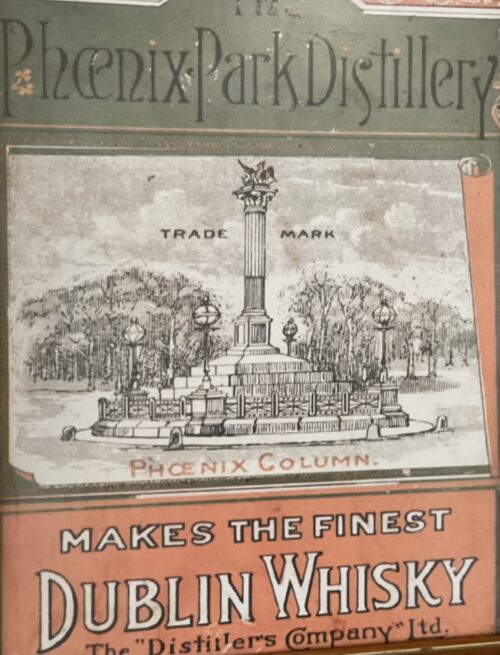
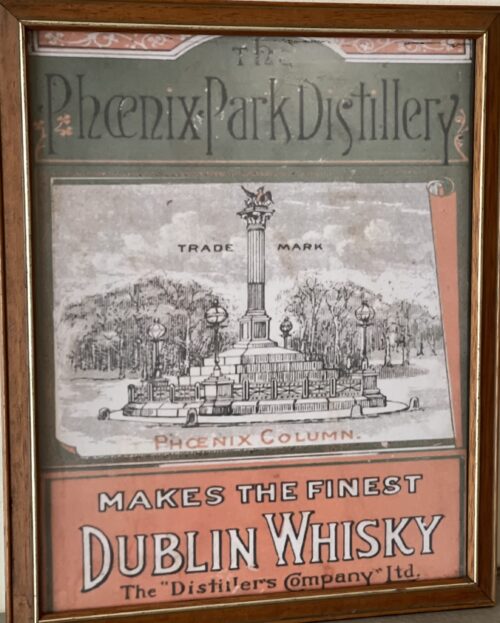 40cm x 34cm Limerick
40cm x 34cm LimerickThe Distillery in Chapelizod, near Dublin's Phoenix Park, was converted from an old mill in 1878 by the Distillers' Company, Ltd., of Scotland, who later went on to become the biggest player in Scotch Whisky owning brands such as Haig, Dewar's, and Buchanan's, as well as countless Malt and Grain Distilleries in Scotland, until the group was taken over by Guinness in the 1980s.
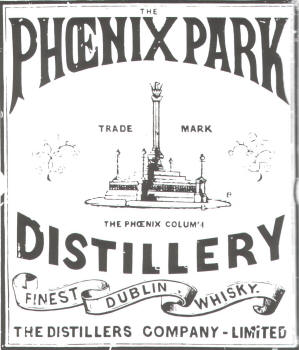 Old Advertisement for Phoenix Park Distillery
Old Advertisement for Phoenix Park DistilleryIt seemed profitable to own an Irish Distillery in those days: Dublin Whiskey, being considered the finest in the world, was priced 25 per cent higher than comparable Scotch Whisky.
The production of Phoenix Park Distillery, 350,000 gallons (1.5 Million Litres) per year, was sold to England and its colonies, as well as used for blending with DCL's own Scottish Malt and Grain Whiskies.
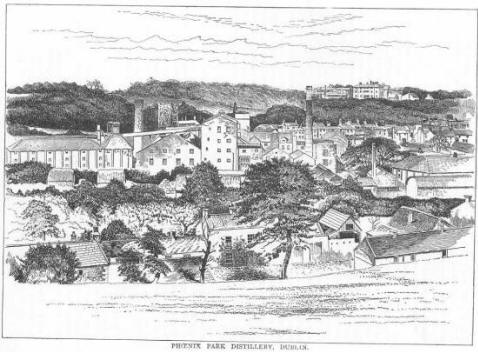 DCL's Phoenix Park Distillery in 1886
DCL's Phoenix Park Distillery in 1886However, Phoenix Park Distillery had only a short life span. Production ceased in 1921, and DCL abandoned the plant a few years later, due to the politically and commercially difficult situation in Ireland at the time.
Today, most buildings have survived, including the mill lade, once holding the largest water wheel in the UK. Others have been converted into apartment houses.
-
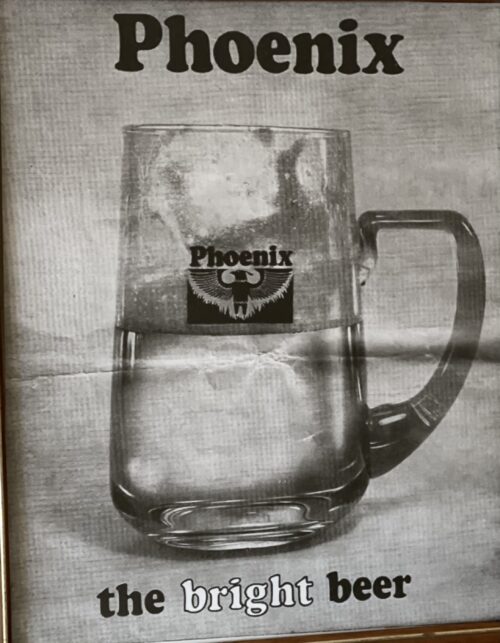
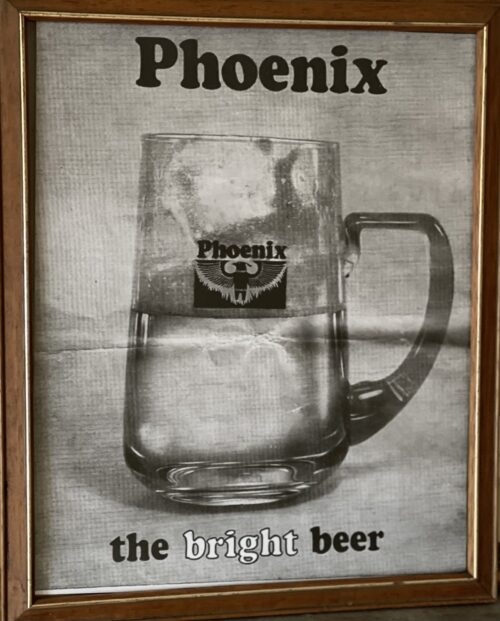 40cm x 35cm Phoenix Brewery (Dublin) Ltd, 89 James's Street, Dublin, Ireland. Founded 1778 and was later known as the Phoenix Porter Brewery Co. Registered January 1897. Acquired by John D'Arcy & Son Ltd 1906 and closed 1909. This brewery publicly advertised itself as "the largest brewery in Ireland but one". Founded in 1788 by Charles Madder who by all accounts was a brilliant technical and innovative brewer. He had come from London to brew porter in Dublin. His business and trading activities were poor and the brewery was rescued by one John Brennan and later his son Charles. Essentially a porter brewery with a capacity to produce 350,000 bulk barrels per annum, it launched its own O'Connell's Dublin Ale. This was probably due to the fact that when they took over Robert Manders & Co's Brewery, their next door neighbours in 1897 it replaced Mander's Dublin Ale. It enjoyed a local and export trade however for whatever the reasons it became bankrupt and closed in 1909. The franchise of brewing O'Connell's Dublin Ale was given to D'Arcys. From:- Breweries and Distilleries in Dublin Francis Coleman moved from 103 to 105 James Street on 15-8-1807. At that time Francis Coleman & Hamilton dissolved their brewing partnership. The Guinness Power station site (now Roe & Co distillery) near the corner of Watling Street occupied part of the site of the Phoenix brewery founded in 1778 by an English brewer called Mather. In 1828 John Brennan bought the brewery and was succeeded by Charles Brenan. Daniel O’Connell junior son of the Liberator acquired the Phoenix Brewery in 1831 which occupies a three acre site at the corner of Watling Street and James’s Street. It operated under the name O’Connell’s brewery for a time. There was a campaign to support their porter as “Catholic” against Guinnness’s “protestant porter“. Daniel O’Connell, the Liberator, refused to support that activity while he was an MP. Guinness was a political rival but was quite liberal on the Catholic Emancipation and Repeal questions. Phoenix acquired the adjoining the six acre Manders brewery site at 111-117 James’s Street and in 1897 the concern became a public company. The brewery extended from James Street to the Quays and had the second largest output in Ireland. John D'Arcy & Son Ltd’s Anchor Brewery bought the Phoenix brewery, then operating for 160 years on 13-6-1905 and it was hoped to continue both breweries as well as the Phoenix brand O’Connell’s ale. However by 13-10-1905 the Phoenix site was for auction.
40cm x 35cm Phoenix Brewery (Dublin) Ltd, 89 James's Street, Dublin, Ireland. Founded 1778 and was later known as the Phoenix Porter Brewery Co. Registered January 1897. Acquired by John D'Arcy & Son Ltd 1906 and closed 1909. This brewery publicly advertised itself as "the largest brewery in Ireland but one". Founded in 1788 by Charles Madder who by all accounts was a brilliant technical and innovative brewer. He had come from London to brew porter in Dublin. His business and trading activities were poor and the brewery was rescued by one John Brennan and later his son Charles. Essentially a porter brewery with a capacity to produce 350,000 bulk barrels per annum, it launched its own O'Connell's Dublin Ale. This was probably due to the fact that when they took over Robert Manders & Co's Brewery, their next door neighbours in 1897 it replaced Mander's Dublin Ale. It enjoyed a local and export trade however for whatever the reasons it became bankrupt and closed in 1909. The franchise of brewing O'Connell's Dublin Ale was given to D'Arcys. From:- Breweries and Distilleries in Dublin Francis Coleman moved from 103 to 105 James Street on 15-8-1807. At that time Francis Coleman & Hamilton dissolved their brewing partnership. The Guinness Power station site (now Roe & Co distillery) near the corner of Watling Street occupied part of the site of the Phoenix brewery founded in 1778 by an English brewer called Mather. In 1828 John Brennan bought the brewery and was succeeded by Charles Brenan. Daniel O’Connell junior son of the Liberator acquired the Phoenix Brewery in 1831 which occupies a three acre site at the corner of Watling Street and James’s Street. It operated under the name O’Connell’s brewery for a time. There was a campaign to support their porter as “Catholic” against Guinnness’s “protestant porter“. Daniel O’Connell, the Liberator, refused to support that activity while he was an MP. Guinness was a political rival but was quite liberal on the Catholic Emancipation and Repeal questions. Phoenix acquired the adjoining the six acre Manders brewery site at 111-117 James’s Street and in 1897 the concern became a public company. The brewery extended from James Street to the Quays and had the second largest output in Ireland. John D'Arcy & Son Ltd’s Anchor Brewery bought the Phoenix brewery, then operating for 160 years on 13-6-1905 and it was hoped to continue both breweries as well as the Phoenix brand O’Connell’s ale. However by 13-10-1905 the Phoenix site was for auction. -

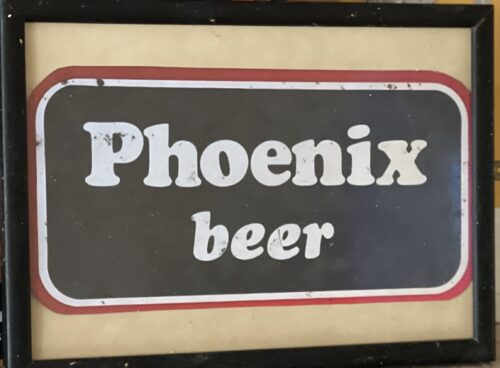 32cm x 27cm Phoenix Brewery (Dublin) Ltd, 89 James's Street, Dublin, Ireland. Founded 1778 and was later known as the Phoenix Porter Brewery Co. Registered January 1897. Acquired by John D'Arcy & Son Ltd 1906 and closed 1909. This brewery publicly advertised itself as "the largest brewery in Ireland but one". Founded in 1788 by Charles Madder who by all accounts was a brilliant technical and innovative brewer. He had come from London to brew porter in Dublin. His business and trading activities were poor and the brewery was rescued by one John Brennan and later his son Charles. Essentially a porter brewery with a capacity to produce 350,000 bulk barrels per annum, it launched its own O'Connell's Dublin Ale. This was probably due to the fact that when they took over Robert Manders & Co's Brewery, their next door neighbours in 1897 it replaced Mander's Dublin Ale. It enjoyed a local and export trade however for whatever the reasons it became bankrupt and closed in 1909. The franchise of brewing O'Connell's Dublin Ale was given to D'Arcys. From:- Breweries and Distilleries in Dublin Francis Coleman moved from 103 to 105 James Street on 15-8-1807. At that time Francis Coleman & Hamilton dissolved their brewing partnership. The Guinness Power station site (now Roe & Co distillery) near the corner of Watling Street occupied part of the site of the Phoenix brewery founded in 1778 by an English brewer called Mather. In 1828 John Brennan bought the brewery and was succeeded by Charles Brenan. Daniel O’Connell junior son of the Liberator acquired the Phoenix Brewery in 1831 which occupies a three acre site at the corner of Watling Street and James’s Street. It operated under the name O’Connell’s brewery for a time. There was a campaign to support their porter as “Catholic” against Guinnness’s “protestant porter“. Daniel O’Connell, the Liberator, refused to support that activity while he was an MP. Guinness was a political rival but was quite liberal on the Catholic Emancipation and Repeal questions. Phoenix acquired the adjoining the six acre Manders brewery site at 111-117 James’s Street and in 1897 the concern became a public company. The brewery extended from James Street to the Quays and had the second largest output in Ireland. John D'Arcy & Son Ltd’s Anchor Brewery bought the Phoenix brewery, then operating for 160 years on 13-6-1905 and it was hoped to continue both breweries as well as the Phoenix brand O’Connell’s ale. However by 13-10-1905 the Phoenix site was for auction.
32cm x 27cm Phoenix Brewery (Dublin) Ltd, 89 James's Street, Dublin, Ireland. Founded 1778 and was later known as the Phoenix Porter Brewery Co. Registered January 1897. Acquired by John D'Arcy & Son Ltd 1906 and closed 1909. This brewery publicly advertised itself as "the largest brewery in Ireland but one". Founded in 1788 by Charles Madder who by all accounts was a brilliant technical and innovative brewer. He had come from London to brew porter in Dublin. His business and trading activities were poor and the brewery was rescued by one John Brennan and later his son Charles. Essentially a porter brewery with a capacity to produce 350,000 bulk barrels per annum, it launched its own O'Connell's Dublin Ale. This was probably due to the fact that when they took over Robert Manders & Co's Brewery, their next door neighbours in 1897 it replaced Mander's Dublin Ale. It enjoyed a local and export trade however for whatever the reasons it became bankrupt and closed in 1909. The franchise of brewing O'Connell's Dublin Ale was given to D'Arcys. From:- Breweries and Distilleries in Dublin Francis Coleman moved from 103 to 105 James Street on 15-8-1807. At that time Francis Coleman & Hamilton dissolved their brewing partnership. The Guinness Power station site (now Roe & Co distillery) near the corner of Watling Street occupied part of the site of the Phoenix brewery founded in 1778 by an English brewer called Mather. In 1828 John Brennan bought the brewery and was succeeded by Charles Brenan. Daniel O’Connell junior son of the Liberator acquired the Phoenix Brewery in 1831 which occupies a three acre site at the corner of Watling Street and James’s Street. It operated under the name O’Connell’s brewery for a time. There was a campaign to support their porter as “Catholic” against Guinnness’s “protestant porter“. Daniel O’Connell, the Liberator, refused to support that activity while he was an MP. Guinness was a political rival but was quite liberal on the Catholic Emancipation and Repeal questions. Phoenix acquired the adjoining the six acre Manders brewery site at 111-117 James’s Street and in 1897 the concern became a public company. The brewery extended from James Street to the Quays and had the second largest output in Ireland. John D'Arcy & Son Ltd’s Anchor Brewery bought the Phoenix brewery, then operating for 160 years on 13-6-1905 and it was hoped to continue both breweries as well as the Phoenix brand O’Connell’s ale. However by 13-10-1905 the Phoenix site was for auction. -

 40cm x 34cm LimerickJames Pierce was born in Kilmore in 1813. His father had a forge in the village where he learned his ironwork skills. In 1839 James opened a small foundry specialising in making ‘fire fans’ in Allen Street, Wexford at the age of 26. Eight years later in 1847, he moved to the site previously occupied by the Folly Corn Mill at the junction of Distillery Road and Mill Road. Here he established the ‘Folly Mills Iron Works and Agricultural Machinery and Implement Factory’ (later known as the Mill Road Iron Works). In 1856 James was contracted to build a new bridge over the Slaney linking Carcur and Crosstown to replace the old 1795 Wexford Bridge linking the town and Ferrybank. The bridge was over a quarter of a mile long and remained in use for almost 100 years until 1959 when the new Wexford Bridge was built. The Folly Mills Iron Works also forged the elaborately designed iron railings and gates for the twin churches, completed in 1858. He also built the cast-iron conservatories at Castlebridge House and Edermine House (for Sir James Power of the Power Whiskey family). Pierce’s Foundry was further developed when James’s son Philip (d.1895) joined his father to run the firm. They worked together for just two years until James died in 1868. His other sons Martin (d.1907) and John (d.1926) also joined the business and Pierce’s became the largest agricultural machinery manufacturer in the country with a workforce of 1,000 by 1914. They had offices at Rue de Flandre in Paris and in Rio de Janeiro and their products were shipped all over the world. Two other foundries opened in Wexford at either end of the town. The Star Iron Works was established on reclaimed land off Trinity Street and close to the south railway station. Selskar Iron Works was set up also on reclaimed land opposite the north railway station (the site is now occupied by Dunnes Stores). However, commercial success was interrupted in August 1911 during the infamous ‘Lock-Out’ when the Pierces sought to prevent workers from joining the ITGWU. Soon all of the foundries in the town had followed suit leading to a series of pickets and protests which were not resolved until February of the following year. Pierce’s were exporting horse-drawn farm machinery to Africa and North and South America, Australia and across Europe up until the 1920s. They had offices in Paris and Buenos Aires. In the early 1900s Pierce Bicycle Works operated on the site of the earlier Bishopswater Distillery for about 10 years but without great success. When the old distillery was demolished in the 1940s Pierce’s built housing for employees along the street front (Alvina Brook, 1946). They also built houses for senior managers overlooking the foundry at Avenue de Flandre, Mulgannon Road (1939) and at Casa Rio, Distillery Road (1947) for middle management. Park House (originally Ballyboggan House, built c.1780) was the Pierce family home in the north of the town. However, as the use of tractors became more common, Pierce’s failed to modernise and continued to manufacture for the ‘horse era’. The business inevitably declined and in 1964 the Pierce family sold the business. Pierce Engineering’s last owners, Waterford Stanley, closed the plant in 2002 with the loss of 62 jobs. The site was sold to Tesco who opened their supermarket in 2007. The enormous Pierce’s Foundry site
40cm x 34cm LimerickJames Pierce was born in Kilmore in 1813. His father had a forge in the village where he learned his ironwork skills. In 1839 James opened a small foundry specialising in making ‘fire fans’ in Allen Street, Wexford at the age of 26. Eight years later in 1847, he moved to the site previously occupied by the Folly Corn Mill at the junction of Distillery Road and Mill Road. Here he established the ‘Folly Mills Iron Works and Agricultural Machinery and Implement Factory’ (later known as the Mill Road Iron Works). In 1856 James was contracted to build a new bridge over the Slaney linking Carcur and Crosstown to replace the old 1795 Wexford Bridge linking the town and Ferrybank. The bridge was over a quarter of a mile long and remained in use for almost 100 years until 1959 when the new Wexford Bridge was built. The Folly Mills Iron Works also forged the elaborately designed iron railings and gates for the twin churches, completed in 1858. He also built the cast-iron conservatories at Castlebridge House and Edermine House (for Sir James Power of the Power Whiskey family). Pierce’s Foundry was further developed when James’s son Philip (d.1895) joined his father to run the firm. They worked together for just two years until James died in 1868. His other sons Martin (d.1907) and John (d.1926) also joined the business and Pierce’s became the largest agricultural machinery manufacturer in the country with a workforce of 1,000 by 1914. They had offices at Rue de Flandre in Paris and in Rio de Janeiro and their products were shipped all over the world. Two other foundries opened in Wexford at either end of the town. The Star Iron Works was established on reclaimed land off Trinity Street and close to the south railway station. Selskar Iron Works was set up also on reclaimed land opposite the north railway station (the site is now occupied by Dunnes Stores). However, commercial success was interrupted in August 1911 during the infamous ‘Lock-Out’ when the Pierces sought to prevent workers from joining the ITGWU. Soon all of the foundries in the town had followed suit leading to a series of pickets and protests which were not resolved until February of the following year. Pierce’s were exporting horse-drawn farm machinery to Africa and North and South America, Australia and across Europe up until the 1920s. They had offices in Paris and Buenos Aires. In the early 1900s Pierce Bicycle Works operated on the site of the earlier Bishopswater Distillery for about 10 years but without great success. When the old distillery was demolished in the 1940s Pierce’s built housing for employees along the street front (Alvina Brook, 1946). They also built houses for senior managers overlooking the foundry at Avenue de Flandre, Mulgannon Road (1939) and at Casa Rio, Distillery Road (1947) for middle management. Park House (originally Ballyboggan House, built c.1780) was the Pierce family home in the north of the town. However, as the use of tractors became more common, Pierce’s failed to modernise and continued to manufacture for the ‘horse era’. The business inevitably declined and in 1964 the Pierce family sold the business. Pierce Engineering’s last owners, Waterford Stanley, closed the plant in 2002 with the loss of 62 jobs. The site was sold to Tesco who opened their supermarket in 2007. The enormous Pierce’s Foundry site -

 65cm x 45cm Nun's Island Distillery was an Irish whiskey distillery which operated in Galway, Ireland, from at least 1815, and possibly as early as the late 1700s, until circa 1908. At its peak, in the late 1800s, output at the distillery reached 400,000 gallons per annum, and with a workforce of over 100, the distillery was one of the largest local employers. Owned by the Persse family from the 1840s onwards, the distillery produced single pot still whiskey known as Persse's Galway Whiskey. The whiskey was sold locally in Connacht, where for much of the 1800s, Nun's Island was the only licensed distillery.However, it was also exported, and is said to have been a sold to the British House of Commons, a fact proudly noted on their labels. Production at the distillery ceased circa 1908, with the remaining stocks wound down off over several few years. A bottle of Persse's whiskey was placed for auction in 2002 with a reserve price of £100,000 - however, it failed to sell. The bottle later sold for £3,300 in 2014.
65cm x 45cm Nun's Island Distillery was an Irish whiskey distillery which operated in Galway, Ireland, from at least 1815, and possibly as early as the late 1700s, until circa 1908. At its peak, in the late 1800s, output at the distillery reached 400,000 gallons per annum, and with a workforce of over 100, the distillery was one of the largest local employers. Owned by the Persse family from the 1840s onwards, the distillery produced single pot still whiskey known as Persse's Galway Whiskey. The whiskey was sold locally in Connacht, where for much of the 1800s, Nun's Island was the only licensed distillery.However, it was also exported, and is said to have been a sold to the British House of Commons, a fact proudly noted on their labels. Production at the distillery ceased circa 1908, with the remaining stocks wound down off over several few years. A bottle of Persse's whiskey was placed for auction in 2002 with a reserve price of £100,000 - however, it failed to sell. The bottle later sold for £3,300 in 2014.History
The early history of the distillery is somewhat difficult to piece together.It is known that a distillery on Nun's Island was being operated on by a John Joyce in the late 1700s.This distillery, which was subsequently taken over by Patrick Joyce, is thought to have ceased operations in 1807. A Patrick Joyce is recorded as running a small distillery on Nun's Island again in 1823. Therefore, it is possible that the closure was temporary. By 1828, output at the distillery had increased to 130,000 proof gallons per annum. There are claims that the distillery ceased operations again in the late 1830s.However, a newspaper advertisement from 1841 reports that a distillery "lately occupied and worked" by Messrs. James and Patrick Joyce was to be sold on 4 February 1841. The advertisement noted that the distillery was held under a 300-year lease, which had commenced in August 1815.This tallies with Alfred Barnard's 1887 report that Joyce's owned the distillery from 1815 to 1840. In about 1840 or 1841, the distillery was purchased by the Persses, a local family who ran several other distilleries in the area.There is some conflicting information with regard to the precise and nature of the sale date. Barnard reported that the distillery was sold by the Encumbered Claims Courts in 1840.However, a newspaper article from the era reports that the distillery was to be sold by private contract in February 1841. As Barnard mentions that the Persses enlarged the original operation, the confusion may be due to piecemeal purchases of different sections of the site, or delays in finalising the sale as the distillery had been repeatedly advertised for sale beginning in at least early 1840. Initially the Persses converted the distillery to a woollen mill, which was known for producing excellent friezes. However, when their lease on the nearby Newcastle Distillery expired in 1846, they moved their distilling operations at the Nun's Island complex, and re-established the site as a distillery. In 1886, the distillery was visited by British historian Alfred Barnard, as recounted in his seminal publication "The Whiskey Distilleries of the United Kingdom". Barnard noted that at the time of his visit Nun's Island was the sole distillery operating in Connacht, and had an output of about 400,000 gallons per annum. In addition to offices, workshops, stables, and storehouses, the distillery buildings included two lofty Maltings and Corn stores built of stone, five storeys of which were devoted to the storing of corn, and two to malting purposes; an elegant brew house equal to any in Ireland; a back house containing thirteen washbacks, each with a capacity of about 18,000 gallons; a still house containing a 16,000 gallon wash still, a 10,000 gallon spirit still, and a 6,000 gallon low-wines still; a spirit store occupied by a 12,000 gallon vat; and five warehouses, holding a total of about 5,000 casks at the time. Like many other Irish distilleries, Nun's Island encountered financial difficulties during the early part of the 20th Century, is thought to have closed shortly before World War I. Since closing, some of the distillery complex has been demolished. However, several of the main distillery buildings, notably the large riverside warehouse, are still extant. -

 60cm x 50cm Limerick
60cm x 50cm Limerick
Paddy is a brand of blended Irish whiskey produced by Irish Distillers, at the Midleton distillery in County Cork, on behalf of Sazerac, a privately held American company. Irish distillers owned the brand until its sale to Sazerac in 2016. As of 2016, Paddy is the fourth largest selling Irish whiskey in the WorldHistory The Cork Distilleries Company was founded in 1867 to merge four existing distilleries in Cork city (the North Mall, the Green, Watercourse Road, and Daly's) under the control of one group.A fifth distillery, the Midleton distillery, joined the group soon after in 1868. In 1882, the company hired a young Corkman called Paddy Flaherty as a salesman. Flaherty travelled the pubs of Cork marketing the company's unwieldy named "Cork Distilleries Company Old Irish Whiskey".His sales techniques (which including free rounds of drinks for customers) were so good, that when publicans ran low on stock they would write the distillery to reorder cases of "Paddy Flaherty's whiskey". In 1912, with his name having become synonymous with the whiskey, the distillery officially renamed the whiskey Paddy Irish Whiskey in his honour. In 1920s and 1930s in Ireland, whiskey was sold in casks from the distillery to wholesalers, who would in turn sell it on to publicans.To prevent fluctuations in quality due to middlemen diluting their casks, Cork Distilleries Company decided to bottle their own whiskey known as Paddy, becoming one of the first to do so. In 1988, following an unsolicited takeover offer by Grand Metropolitan, Irish Distillers approached Pernod Ricard and subsequently became a subsidiary of the French drinks conglomerate, following a friendly takeover bid. In 2016, Pernod Ricard sold the Paddy brand to Sazerac, a privately held American firm for an undisclosed fee. Pernod Ricard stated that the sale was in order "simplify" their portfolio, and allow for more targeted investment in their other Irish whiskey brands, such as Jameson and Powers. At the time of the sale, Paddy was the fourth largest selling Irish whiskey brand in the world, with sales of 200,000 9-litre cases per annum, across 28 countries worldwide. Paddy whiskey is distilled three times and matured in oak casks for up to seven years.Compared with other Irish whiskeys, Paddy has a comparatively low pot still content and a high malt content in its blend. Jim Murray, author of the Whiskey bible, has rated Paddy as "one of the softest of all Ireland's whiskeys".

Introduced 1879, renamed as Paddy in 1912 -

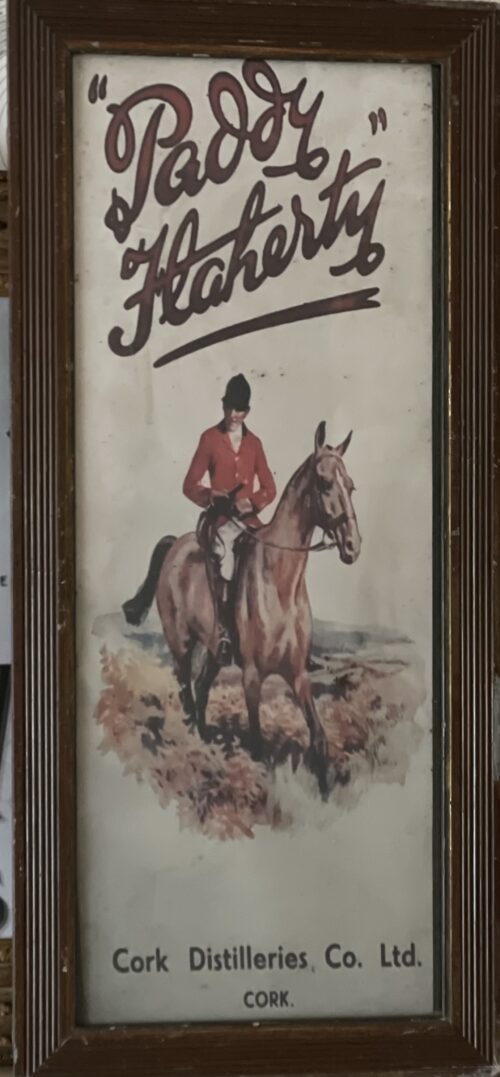 60cm x 38cm Limerick
60cm x 38cm Limerick
Paddy is a brand of blended Irish whiskey produced by Irish Distillers, at the Midleton distillery in County Cork, on behalf of Sazerac, a privately held American company. Irish distillers owned the brand until its sale to Sazerac in 2016. As of 2016, Paddy is the fourth largest selling Irish whiskey in the WorldHistory The Cork Distilleries Company was founded in 1867 to merge four existing distilleries in Cork city (the North Mall, the Green, Watercourse Road, and Daly's) under the control of one group.A fifth distillery, the Midleton distillery, joined the group soon after in 1868. In 1882, the company hired a young Corkman called Paddy Flaherty as a salesman. Flaherty travelled the pubs of Cork marketing the company's unwieldy named "Cork Distilleries Company Old Irish Whiskey".His sales techniques (which including free rounds of drinks for customers) were so good, that when publicans ran low on stock they would write the distillery to reorder cases of "Paddy Flaherty's whiskey". In 1912, with his name having become synonymous with the whiskey, the distillery officially renamed the whiskey Paddy Irish Whiskey in his honour. In 1920s and 1930s in Ireland, whiskey was sold in casks from the distillery to wholesalers, who would in turn sell it on to publicans.To prevent fluctuations in quality due to middlemen diluting their casks, Cork Distilleries Company decided to bottle their own whiskey known as Paddy, becoming one of the first to do so. In 1988, following an unsolicited takeover offer by Grand Metropolitan, Irish Distillers approached Pernod Ricard and subsequently became a subsidiary of the French drinks conglomerate, following a friendly takeover bid. In 2016, Pernod Ricard sold the Paddy brand to Sazerac, a privately held American firm for an undisclosed fee. Pernod Ricard stated that the sale was in order "simplify" their portfolio, and allow for more targeted investment in their other Irish whiskey brands, such as Jameson and Powers. At the time of the sale, Paddy was the fourth largest selling Irish whiskey brand in the world, with sales of 200,000 9-litre cases per annum, across 28 countries worldwide. Paddy whiskey is distilled three times and matured in oak casks for up to seven years.Compared with other Irish whiskeys, Paddy has a comparatively low pot still content and a high malt content in its blend. Jim Murray, author of the Whiskey bible, has rated Paddy as "one of the softest of all Ireland's whiskeys".

Introduced 1879, renamed as Paddy in 1912









